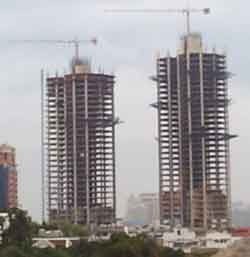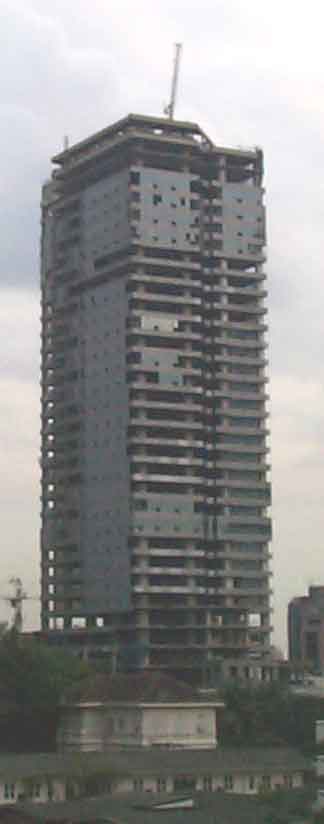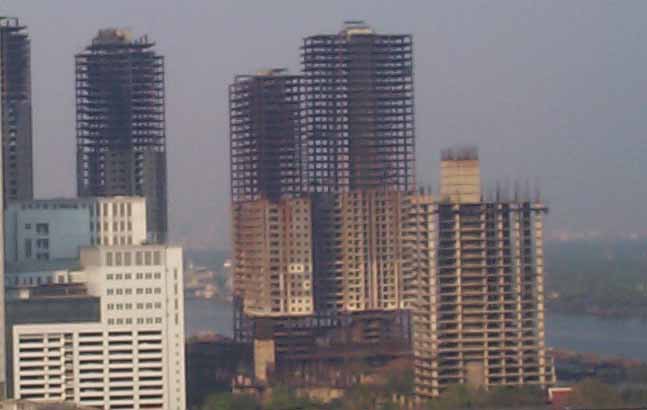
The 1997 Asia Economic Collapse
 Left photo: Two of the many "monuments to speculators". Most have been abandoned since 1997, including their construction cranes which haven't moved and have been rusting...
Left photo: Two of the many "monuments to speculators". Most have been abandoned since 1997, including their construction cranes which haven't moved and have been rusting...
(There are more awesome photos than the ones on this page, e.g., of clusters of very tall and very wide buildings, all abandoned. I've not made much of an effort to photograph buildings around town, but I do have a few in stock.)
The material in this article was written largely in 1997 and then edited in subsequent years. It's actually been a few years since I edited this article; nevertheless, it's quite valid for the most part, except that the property market has boomed again the last few years. An interesting exception is Muang Thong Thani (at www.MTTBKK.com , another website of mine) which is an unfinished suburban "satellite city" megaproject with tremendous potential for investors. The Thai company simply got too burdened with debts.
The Asia economic collapse was the result of overbuilding in real estate, and originated in Thailand, spreading to other countries whose big financial players had invested in Thailand, especially Japanese banks.
When you come to Bangkok, you will be impressed with all the beautiful modern highrises. Bangkok looks very rich on the outside at first glance.
On the inside, it's a different picture. Many buildings have completed glass facades on the outside which make them look finished, but are wholly or partly incomplete on the inside. The only ways you can tell from the outside are that there are no lights on when the sun sets, or a pattern of open windows for ventilation, and sometimes a number of broken windows in random places that never get repaired (why, I don't know). They disappear into the darkness of the night. (Update: Most of these resumed development around 2002 and were filled by 2007, but there are still some abandoned ones around.)
In some buildings, they've completely fitted out a few floors and opened them to clients, but most floors are still empty shells. (1997) If you get off the elevator on the wrong floor, what a different world! Imagine stepping out into a wide open floor with just a few cement columns or steel beams spaced around, and a bare cement floor and ceiling. No, it isn't the parking lot without cars.
 A third kind of building which is quite common on the Bangkok landscape doesn't even have the outside completed. They are see-thru skeletons of concrete, often dozens of levels high. If you think it's strange that the construction cranes aren't moving in the day, well, most of them haven't moved since 1997. (This article was written in the year 2000, and revised in 2003 -- not much has changed.) Did you notice that the steel rods (rubar) on top are rusted? And that rust from them has washed down the side of the building by multiple rains? And that the cement's dirty from pollution? That nothing appears new and nothing changes over the days, weeks, months, even years?
A third kind of building which is quite common on the Bangkok landscape doesn't even have the outside completed. They are see-thru skeletons of concrete, often dozens of levels high. If you think it's strange that the construction cranes aren't moving in the day, well, most of them haven't moved since 1997. (This article was written in the year 2000, and revised in 2003 -- not much has changed.) Did you notice that the steel rods (rubar) on top are rusted? And that rust from them has washed down the side of the building by multiple rains? And that the cement's dirty from pollution? That nothing appears new and nothing changes over the days, weeks, months, even years?
There are buildings in various stages of completion and decay spread around, and many been frozen in that state since around 1997. One website which tracks them is by WaxWings on GeoCities.
Thailand boomed starting in the mid-1980's, and nearly all of the beautiful modern highrises in Bangkok come from the 1985-1997 period. Before and during this period, many Thais had gotten rich by owning property and selling or leasing it for development. Rich Thai players in collusion with local and foreign banks (largely Japanese) loaning the money just kept on building, trying to get ever richer and more powerful in status, based on their sensational past experiences. Driven by greed which blinded them from the obvious overbuilding, they were in denial when the first warning signs came out in 1995. Given the corruption and rackets commonly involved in getting building licenses and lining up construction supplies, some thought they had a virtual monopoly on getting ever richer.
The result was an immense property glut. They couldn't rent out enough of their new office and condo space. Further, prices plummeted due to oversupply, so they couldn't get nearly as much money on what they did rent out. When the bank loans became due, they couldn't pay. When big shot A couldn't pay contractors B, C and D, then contractors B, C and D couldn't pay suppliers E, F, G, H, I and J, who in turn couldn't pay... and on down the economy, there were countless businesses that had a cash flow crisis. This is called a "liquidity" crisis. Many old dinosaurs died, stuck in a tar pool. Their cement skeletons languish on the skyline. Others became financially disabled but hanging on while languishing.
Understand, companies B thru Z looked very good on paper if you looked at their balance sheets for accounts receivable vs. accounts payable. The problem was that they weren't getting paid what they were due. When their accounts receivable weren't received, then their accounts payable weren't paid, and that was repeated on down the food chain... the cash "liquidity" crisis.
There were also a lot of issues regarding "transparency", especially when the IMF (International Monetary Fund) was called in to drop a lot of cash into the Thai economy to improve liquidity and stir up the cash flow between key entities.

The IMF, under pressure by international business powers, and was eventually invited in formally by the Thai government, to deal with this liquidity crisis. If cash in the form of loans could be injected into the accounts of, say, entities B, C and D, then this cash would circulate thru the economy and reduce the impact of the bad loans. If the economy keeps going by reestablishing cash liquidity, then businesses can survive and debts can be repaid over time. But if everyone is sitting on their hands every day and not producing goods or services, then the economy will continue to grind down to a crawl. Given international business interdependence, this would spread to other countries. It is the job of the IMF to institutionally deal with these kinds of crises.
Not everyone was for the IMF to help. Many powerful Thai businessmen and politicians who were responsible for the crisis resisted the arrival of the IMF, because the IMF would make the loans conditional on reforms, and would institute accountability and transparency. Many critics argued against the IMF passing money into an allegedly flawed economic system as it would deal only with the symptoms, not the underlying problem, and might be counterproductive in the long term.
The IMF worked on loans conditional on a set of reforms.
For starters, it required that 56 financial institutions be closed, declared bankrupt, and their assets liquidated to help pay back debts. This was most of the major finance companies in Thailand. They were owned and operated by powerful people, many of whom were closely associated with the government in power. This also required reformation of the bankruptcy laws in Thailand.
Another requirement was increased "transparency", i.e., increased openness of financial institutions to government auditing, so that the government could see where money was going, especially money coming in from the IMF. Since Thailand has a lot of corruption and there are a lot of powerful players who want to keep secret their ways of extracting money from financial institutions in questionable ways, this created a political crisis.
The majority party in power in Parliament split into factions fighting each other over these issues and disintegrated, with the opposition taking over as the majority voting power and a new Prime Minister, Chuan Leekpai, known as one of the most honest and humble of politicians in Thailand, took the helm. Over the next year, Thailand underwent many political, economic and social reforms, including sweeping anticorruption measures and strengthening of checks & balances systems. An entire new constitution was written and passed, and election laws were reformed.
In a way, the 1997 crash is laying the foundation for a better Thailand, by having forced greater transparency, reform of financial institutions, and reduction of corruption.
(These mammoth unfinished buildings remind me of dead dinosaur skeletons, representing an older generation of players in the pre-reform, pre-1997 Thailand. That cement is made from limestone, a fossil rock from seabed deposits of skeletons of prehistoric sea creatures, is ironic. You don't see steel frame buildings in Thailand. Unlike other countries, Thailand is poor in iron ore, but very rich in limestone. Construction companies were often run by quasi-mafia characters. Many of these were caught with a big manmade rock on their hands in 1997.)
The slang phrase for these monoliths are "monuments to speculators".
It's remarkable that when I first arrived in 1994, I was taken aback by the amount of construction going on. I had never seen a city in the world growing this fast. Looking from my 8th floor terrace, I could see dozens of construction cranes on highrises going up. It was nothing less than amazing. Yet the locals saw nothing wrong. Thailand's economy was one of the fastest growing in the world over the previous 10 years, and everyone seemed to feel they'd hit the jackpot economy. I switched fields and joined in as a computer consultant to engineering design companies, architecture companies, construction companies, and property development companies. Business was great ... until 1996-97.
Bills started getting paid slower, then gossip started spreading, cranes stopped, bills went unpaid, foreigners started to flee over a remote border (managing directors and others who were legally liable or accountable in one way or another), companies closed and laid off people (including foreigners with leases who were left without a last paycheck nor a plane ticket, forget the contract!), all kinds of wild stuff. Some diehards kept pointing to their accounts receivable sheets longer than others. (I had some invoices that were never paid, but looking around, I felt lucky in comparison to others.)
The final straw was the floating of the Thai currency, the baht. It had been pegged at 25 baht to the dollar, but Thailand lost vast sums in foreign currency and the government was forced to float the baht when it ran out of foreign exchange reserves. That occurred on July 2, 1997, which officially marks the beginning of the Asia Economic Crash.
The baht very quickly dropped to 33 baht to the dollar (a 50% drop) and continued to slide all the way to 57 baht to the dollar. This affected companies in Thailand which had borrowed from overseas, which more than doubled their debt in terms of Thai baht. They just went bankrupt, or the functional equivalent of bankrupt (given undeveloped bankruptcy laws in Thailand at the time).
In turn, those foreign financial institutions suddenly had massive non-performing loans (NPLs) on their books which were hopeless write-offs, and the liquidity problem spread, especially to Japanese banks which were heavily invested in Thailand. The entire Asia region fell like dominoes.
The foreign engineering and construction community has a social organization called The Lighthouse Club. (I've done their website, lighthousebkk.com , since before the crash when it had a different domain.) The Lighthouse Club's last "Construction Ball" before the crash was sold out with more than 500 attendees. The very next year, after the crash, less than 20 people bought tickets and it was cancelled. Of the foreign engineering and construction companies that were still functioning in Thailand, many had cut most of their staff, often including all their foreigners except the Managing Director(s). Many companies had exactly one foreigner -- the Managing Director.
The economy has restructured and started recovering around 2002. Engineering, construction and property development were hardest hit, as were luxury goods and imports, whereas exports picked up in activity with the devaluation of the baht, and the core local economy kept going.
The economy will never be the same as it was before, because many of the biggest players who fueled the former economy are now financially disabled, and Thailand's nationalistic laws regarding property prevent foreign players from moving into the local market to pick up much of the slack. Nonetheless, it is a free enterprise economy, and many opportunities exist.
With the real estate glut, you could get prime office space for very cheap ... if you negotiated something close to market price rather than commonly inflated asking prices. Labor in Thailand is still also relatively very cheap, and there is even more of a glut of it now, including Thais who formerly worked for multinational engineering design companies during the former real estate boom. Indeed, some multinationals continued to survive and sometimes even prosper by selling services overseas by Internet, i.e., offshore services, using cheaper Thai labor. For example, some engineering and drafting companies design buildings in the U.S. and Australia, sending the CAD drawings via Internet.
Living in Thailand also has its benefits in terms of personalized services such as maids, drivers and servants, and housing is relatively inexpensive when compared to the equivalent standard in a western country.
What is different from the pre-1997 period is that most of the big powerful players are gone, and the Thailand of the future will be built more by the middle class and foreign investors, compared to the Thailand of pre-1997.
However, a lasting byproduct of the coup was the first election after the crisis. Few rich people were left standing, but one of them was Thaksin Shinawatra, who had made his fortune in telecommunications. He set up a new party from nothing, created a populist agenda, threw money around in this desperate environment, and in this political vacuum got his new party elected with an absolute majority in Parliament, with him as Prime Minister. All within about a year.
Then he abused that power. The subsequent massive corruption, and wanton disabling of anti-corruption reforms, is what eventually led to the popular 2006 military coup. Everyone thought that military coups were a thing of the past, but one more was deemed necessary. This coup government pretty much just started enforcing the laws which the corrupt administration had been disregarding and undercutting. Following the original anti-corruption laws, in May 2007, the party that Thaksin Shinawatra had founded, Thai Rak Thai, was disbanded by court order and more than 100 of its leaders banned from politics for 5 years.
The coup will probably be the final major repercussion of the 1997 Asia Economic Crisis, as the economy has been booming, many safeguards have been set up to prevent a repeat, and practically everyone wants democracy with a strong checks and balances system. Thailand has learned a lot from these experiences and instituted key reforms, and I think it's well positioned for the future, especially by Asia standards.
 > History, culture, situation > 1997 Asian Economic Crash
> History, culture, situation > 1997 Asian Economic Crash
Copyright 1999 -
2025 by Mark Evan Prado, All Rights Reserved.
Notably, I get quickly notified of copies of tracts by the CopyScape / CopySentry automatic search engine & notifier.
Short quotes are often OK and can be approved, if there is a clear reference and web link back to my website from the quoted material, and if you send me a short message. I try to help people with good intentions, and try to help the world. Not thieves. Links back to this website are helpful for sustainable progress, thank you!
Please have honor and class by following intellectual property and internet protocols. Be a good kind of person in life.
|
Want to privately ask the Thailand Guru? Contact us.
|
|
Some of the services discussed on Thailand Guru are provided by our friendly staff in our 2 companies: |
|
|
Lucky Lion Pride Co., Ltd.
|
|
| DISCLAIMER: Although efforts have been made to ensure the information on this website was correct at the time of electronic publication, ThailandGuru and all its associates do not assume and hereby disclaim any liability to any party for any loss or damage caused by errors, omissions or misleading information resulting from negligence, accident or any other cause. If you choose to take any of this advice, it is at your own risk and no other entity's. ThailandGuru and its associates will take no responsibility. The only thing we guarantee is that our website information can take bandwidth, memory and/or disk space, at least temporarily. Guru is relative. | |
Menu: Site Map